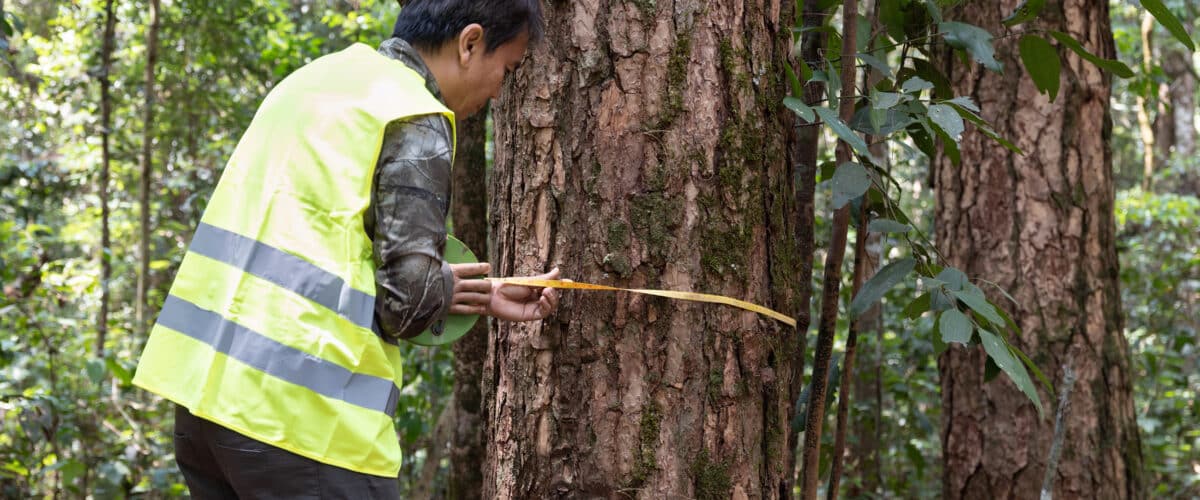How do carbon credits work and how can companies purchase carbon credits?
Setting and achieving corporate climate targets is a laudable yet challenging goal. As much as you may want to reduce greenhouse gas (GHG) emissions, transitioning to net zero can take decades. However, buying carbon credits can help you compensate for emissions that you can not yet eliminate or those that are nearly impossible to avoid.
For example, your company might be working on a plan to reduce supply chain emissions by changing suppliers. Since reorienting your supply chain can take time, you might purchase carbon credits in the short-term to help reduce your climate impact. Or, you might be working toward reaching Science Based Targets initiative (SBTi) goals.
The SBTi Corporate Net-Zero standard stipulates that companies with net zero targets must reduce over 90% of their emissions and “use permanent carbon removal and storage” to neutralize the remaining <10% by 2050. Companies can use removal-based carbon credits to counterbalance these residual emissions.
In this article, we’ll take a closer look at:
- What are carbon credits?
- How does buying carbon credits fit into a corporate climate strategy?
- What criteria should you consider when buying carbon credits?
- How to purchase carbon credits
What are carbon credits?
Carbon credits represent the avoidance, removal, or reduction of one metric tonne (Mt) of carbon dioxide equivalent emissions (CO2e) per credit. These credits are market-based instruments that can be bought and sold as a way to fund climate mitigation projects or counterbalance the emissions that an entity generates.
For example, if an employee takes a business trip, where the flights generate 10 Mt of CO2e, the company might purchase 10 carbon credits to compensate for the flight emissions. The carbon credit does not directly reduce the emissions from this flight or necessarily make the flight sustainable, as the better environmental option could be to skip the flight entirely.
Consider the following examples of carbon credit projects across different categories:
- Carbon avoidance credits: A carbon credit might fund a wind farm as a form of emissions avoidance. Doing so can make renewable energy more affordable, helping others avoid emissions that fossil fuels would have otherwise generated.
- Carbon reduction credits: Buying a carbon credit could finance a reduction in carbon emissions, such as how landfill methane capture directly reduces emissions that would otherwise end up in the atmosphere.
- Carbon removal credits: Carbon credits can also directly remove CO2 emissions in the atmosphere, such as through carbon capture and storage technologies that pull existing emissions out of the atmosphere and sequester them underground.
How do carbon credits fit into a climate strategy?
Carbon credits should not be a substitute for value chain emission reduction measures. Instead, carbon credits can complement a larger climate strategy that involves establishing climate targets, reducing direct emissions, and addressing unavoidable ones.
An electronics company, for example, may set a 2050 net zero goal and work to directly reduce their greenhouse gas emissions by sourcing renewable energy to power their operations. However, they may choose to purchase carbon credits to address the ongoing impacts of hard-to-decarbonize activities, such as mining metals.

Carbon credits also might fit into a climate strategy based on their co-benefits, many of which map to U.N. Sustainable Development Goals (SDGs). For example, a beverage company’s climate strategy might include goals like supporting SDG 6: Clean Water and Sanitation. The company might purchase carbon credits that fund improved forest management projects that both remove emissions via carbon sequestration and support the water quality of streams and lakes within these forests.
Some organizations are cautious about using carbon credits as part of their climate strategies due to concerns over being accused of “greenwashing” or delaying “real” climate action. This is why carbon credits must be used as a complement to, rather than a substitute for, value chain emissions reductions. Companies should also make accurate, transparent, and specific claims about how they use carbon credits, without overstating climate impact. In other words, carbon credits should not defer action on climate change, but they can be used to support climate action beyond what can be accomplished through reductions alone, such as by addressing unabated emissions.
What criteria should companies consider when procuring carbon credits?
To procure high-quality carbon credits, you want to make sure that your purchase meets the following key quality criteria:
-

Field ecologist taking measures carbon in forests and track greenhouse gas emissions for monitoring biodiversity and forest condition.
Additionality: Additionality means that the revenue from purchasing carbon credits provides a meaningful incentive to the project, allowing them to avoid, reduce, or remove GHG emissions beyond what would have occurred without the carbon credit funding.
- Durability/Permanence: A high-quality carbon credit should also have durability, also called permanence. This means that projects that sequester and store carbon in natural or geologic reserves must be supported by measures to protect or insure against reversals over a specified period.
- Quantification: A high-quality carbon project should provide clear quantification of emissions benefits in comparison to the baseline of what would have occurred if the project did not exist.
- No double-counting: If more than one organization claims a carbon credit, then the emissions benefits would be overstated. Organizations need to ensure that any credits purchased will not be double-counted. This can be done by purchasing third-party verified carbon credits that are properly accounted for and retired by a carbon registry after procurement.
- Co-benefits: Co-benefits, also referred to as sustainable development benefits for those that align with SDGs, provide additional positive outcomes beyond carbon benefits. Some examples of co-benefits can include habitat preservation that supports biodiversity, financial flows to Indigenous communities, and job creation that advances gender equality. Co-benefits are not required for all carbon credits but can be a marker of carbon credit quality as part of an equitable transition to a net-zero economy.
Don’t feel like you need to assess all of these issues completely on your own. You should purchase credits that have already been verified and validated by internationally recognized standards bodies/registries, including the American Carbon Registry (ACR), Climate Action Reserve (CAR), Gold Standard (GS), or Verra. These registries provide oversight to the voluntary carbon market, ensuring that carbon credit projects adhere to independently developed quantification methodologies.
To assess carbon credit quality, you can also look to new third-party standards bodies such as the Integrity Council for Voluntary Carbon Markets (ICVCM), which seeks to establish a global high-quality threshold standard for all credits through its Core Carbon Principles (CCPs). Credits that meet the ICVCM’s elevated quality criteria will be labeled as “CCP-Approved” within registries as early as Q1 2024, although it will likely take at least a year for the majority of existing credits to be reviewed by the ICVCM.
How to buy carbon credits
Organizations looking to purchase carbon credits typically explore online marketplaces or collaborate with climate retail partners. While online marketplaces offer a quick, straightforward procurement route, they may lack the personalized guidance necessary for aligning with broader, long-term sustainability goals.
Working with a trusted climate retail partner can provide a more tailored approach. retail partners often have access to a wider variety of carbon credit projects, ensuring alignment with your company’s overall strategy, such as supporting specific U.N. Sustainable Development Goals (SDGs).
Moreover, retail partners can offer unique financial structures to support carbon credit procurement. This might include making prepayments to finance new projects, securing future carbon credit supply, or taking equity stakes in project development for more direct involvement.
Another key advantage of partnering with a retail partner is the potential for procuring larger volumes of carbon credits at more competitive prices. Unlike the one-size-fits-all nature of marketplaces, retail partners can negotiate and source projects that cater specifically to your company’s needs and budget.
Ultimately, the choice between a marketplace and a retail partner should be informed by your organization’s specific climate strategy and sustainability objectives. A retail partner’s expertise can be particularly valuable in crafting a comprehensive approach that not only meets your immediate needs but also positions you strategically for future sustainability endeavors.
Interested in integrating carbon credits into your organization’s comprehensive climate and sustainability strategy? Reach out to us at 3Degrees. Our experienced carbon team, specializing in project development, procurement, and advisory services, has successfully facilitated the procurement of over 14 million carbon credits globally. We’re not just about transactions; we’re about tailoring solutions that fit your unique sustainability vision. Contact us today, and let’s explore how carbon credits can become a pivotal part of your climate action plan.
FAQs
Curious about buying carbon credits but still have questions? Take a look at these FAQs.
How do carbon credits work?
Carbon credits work by funding projects that avoid, reduce, or remove the equivalent of one metric ton of carbon emissions per credit. When a project developer achieves this carbon benefit, such as by planting trees to remove emissions or building out a wind farm to avoid fossil fuel emissions, they work with a third party, such as a carbon registry, to verify the project’s legitimacy before selling it.
A high-quality carbon registry ensures that a carbon credit meets criteria such as having additionality, meaning the emissions benefits would not have occurred without funding from selling the carbon credit. The registry also ensures that the project is properly accounted for, such as by verifying that only one buyer claims the credit to avoid issues with double-counting emissions benefits.
How do you buy carbon credits?
For companies wondering how to buy carbon credits, the answer depends on what type of carbon credits you procure.
If you want an off-the-shelf carbon credit that doesn’t necessarily have co-benefits, you can purchase carbon credits from a carbon credit marketplace/broker. Or, you could work with a climate consultant to source more unique carbon credits that align with your corporate sustainability strategy.
For more about buying carbon credits and understanding how carbon credits work, see our article on carbon credits FAQs.

